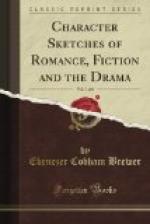A’HABACK AND DES’RA, two enchanters, who aided Ahu’bal in his rebellion against his brother Misnar, sultan of Delhi. Ahu’bal had a magnificent tent built, and Horam the vizier had one built for the sultan still more magnificent. When the rebels made their attack, the sultan and the best of the troops were drawn off, and the sultan’s tent was taken. The enchanters, delighted with their prize, slept therein, but at night the vizier led the sultan to a cave, and asked him to cut a rope. Next morning he heard that a huge stone had fallen on the enchanters and crushed them to a mummy. In fact, this stone formed the head of the bed, where it was suspended by the rope which the sultan had severed in the night.—James Ridley, Tales of the Genii ("The Enchanters’ Tale,” vi.).
AHASUE’RUS, the cobbler who pushed away Jesus when, on the way to execution. He rested a moment or two at his door. “Get off! Away with you!” cried the cobbler. “Truly, I go away,” returned Jesus, “and that quickly; but tarry thou till I come.” And from that time Ahasuerus became the “wandering Jew,” who still roams the earth, and will continue so to do till the “second coming of the Lord.” This is the legend given by Paul von Eitzen, bishop of Schleswig (1547).—Greve, Memoir of Paul von Eitzen (1744).
AHER’MAN AND AR’GEN, the former a fortress, and the latter a suite of immense halls, in the realm of Eblis, where are lodged all creatures of human intelligence before the creation of Adam, and all the animals that inhabited the earth before the present races existed.—W. Beckford, Vathek (1786).
AH’MED (Prince), noted for the tent given him by the fairy Pari-banou, which would cover a whole army, and yet would fold up so small that it might be carried in one’s pocket. The same good fairy also gave him the apple of Samarcand’, a panacea for all diseases.—Arabian Nights’ Entertainments ("Prince Ahmed, etc.").
AHOLIBA’MAH, granddaughter of Cain, and sister of Anah. She was loved by the seraph Samias’a, and like her sister was carried off to another planet when the Flood came.—Byron, Heaven and Earth.
Proud, imperious, and aspiring, she denies that she worships the seraph, and declares that his immortality can bestow no love more pure and warm than her own, and she expresses a conviction that there is a ray within her “which, though forbidden yet to shine,” is nevertheless lighted at the same ethereal fire as his own.—Finden, Byron Beauties.
AH’RIMAN OR AHRIMA’NES (4 syl.), the angel of darkness and of evil in the Magian system, slain by Mithra.
AIKWOOD (Ringan), the forester of sir Arthur Wardour, of Knockwinnock Castle.—Sir W. Scott, The Antiquary.
AIMEE, the prudent sister, familiarly known as “the wise one” in the Bohemian household described by Francis Hodgson Burnett in Vagabondia (1889).




